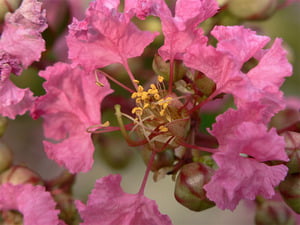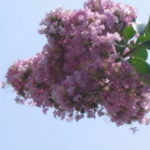If you have a white fuzzy coating on the leaves of your ornamentals or vegetable plant leaves, you probably have powdery mildew. Powdery mildew does not need damp places to grow like most mildews. In fact, it prefers dry days and warm nighttime temperatures in the 60-80 degree range, which we have at night during our growing season.
Powdery mildew thrives on roses, crape myrtles, zinnias, pea, squash and watermelon plants. I’ve also seen it on cucumber vines, grape vines, fruit trees, and yard trees like sycamores. Some plants take it in stride, but the mildew might kill other plants such as roses and fruit trees, and is usually fatal for vegetable plants. The most effective control method is a good planting location that has plenty of sunlight and good air circulation. (On a side note, crepe myrtle varieties with Indian names such as Natchez, are less prone to powdery mildew.) Be sure there is good air circulation and a space between plants, so don’t crowd them together. If a vegetable plant is severely infected and the other plants of the same variety around it are doing well, pull the infected plant and throw it away. Also, use organic fertilizers that release nitrogen slowly into the soil. Fertilizing with a high nitrogen chemical fertilizer will give you lots of unnatural new top growth that is susceptible to damage from powdery mildew. For foliar feeding, seaweed, fish emulsion and compost teas are the best choice. Here’s some other ideas to control powdery mildew:
Wettable Sulfur is highly effective against powdery mildew. If you use a sulfur-based product, use on a regular 10-14 day spraying program but test on a small area first. Some plants, such as those from the cucumber and squash family, cannot tolerate any sulfur and the leaves will dry out, crack and fall off. A more organic solution is a garlic-based spray that has naturally occurring sulfur and is not as toxic to your plants. A homemade garlic spray recipe is to pulverize 10 cloves of garlic in a blender. Pour mixture in one gallon of water. Let sit for 3 days, then strain and pour into sprayer. Add one tsp of Dr. Bronner’s Soap. Mix well and apply as needed in the evening.
Baking soda or Sodium Bicarbonate mixed with water is routinely used for powdery mildew, but Potassium Bicarbonate is better because you are not adding the sodium, or salt, to your soil. Just add 1 teaspoon to one quart of water with two drops of liquid soap such as Dr. Bronner’s Soap. Spray in the cool of the day. You can find Potassium Bicarbonate anywhere organic gardening supplies are sold.
Milk mixed with water at a ratio of 1 part milk to 9 parts water seems to work well on zucchini and squash plants. Don’t overdo it with the milk. A ratio higher than what is recommended will increase the chance of another type of fungus that is worse than powdery mildew. Skim milk works just as well as milk fresh from the cow.
Neem Oil a highly effective and organic solution for powdery mildew as islighthorticultural oil, but don’t use oils in temperatures above 90 degrees. Use oil sprays with caution by testing a small area first and follow all directions carefully.
Powdery mildew spends the winter on twigs and stems of many host plants. That’s why it’s a good idea to keep the garden free of weeds and clear of debris during the winter.
More Gardening info and book, plant, and seed sources on my website.



